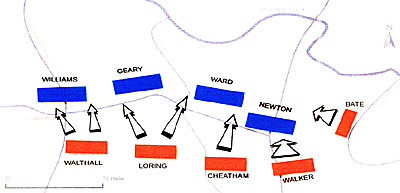 The scenario concentrates on the
battle for the Union left commencing at 3 PM and
continuing until the onset of darkness at 7:15 PM.
The Federal skirmish line (marked 791102 on the
map, in front of Harrison's brigade) is a combined
detachment from both those regiments. It is
considered a separate entity for all gaming
purposes.
The scenario concentrates on the
battle for the Union left commencing at 3 PM and
continuing until the onset of darkness at 7:15 PM.
The Federal skirmish line (marked 791102 on the
map, in front of Harrison's brigade) is a combined
detachment from both those regiments. It is
considered a separate entity for all gaming
purposes.
Kimball and Blake's brigades are behind hasty works, and these do not extend to the skirmishing units on the Union left. Some Federal units came under Confederate artillery fire, but I cannot find any information that identifies these batteries. Therefore, I have chosen to include a few at random. Due to the small size of many regiments, I recommend merging units with 200 men or under.
Regimental strengths are always a problem when dealing with the Civil War. The Confederates usually bear the brunt of the blame, as their returms are infamously short of the kind of information that the wargamer feeds on. However, for the Atlanta campaign, the Union returns are almost as bad. They include plenty of information on casualties, but not on regimental or brigade strengths. Looking through these reports on the three days of fighting depicted in these scenarios, it becomes dear that many regiments and brigades on both sides were commanded by lower echelon commanders, i.e. colonels, majors, or even captains.
Thus, I can only suppose that these men were either too busy living up to their new positions, or did not have enough experience, to formulate proper reports or returns, hence, the differing quality from the norm. It is also apparent that, although the Union forces outnumbered the Rebels by a considerable amount, overall they still maintained the large organization (three armies) with which they had begun the campaign. This meant that the number of units stayed the same, while their actual complements diminished. The Confederates in the West frequently amalgamated their regiments fairly early in the conflict. Although as a rule the Federals did not do so, in the west, at least they often joined depleted regiments to form 'battalions' within a brigade organization.
Many Union regiments were partially equipped with repeating rifles during this campaign. However, to find a whole regiment thus armned was not the norm. These weapons were usually in short supply, and they were generally used by companies accustomed to skirmishing duties. I find that most rules systems tend to overcompensate for these weapons, and turn them into early versions of machine guns (to the detriment of the game). Therefore, any unit marked RR(p), (Colt rifles), or RR should not be able to fire twice if using JR2 rules, but instead, they only receive an up 1 column shift on the fire table. If not using JR, or if you disagree, then I will leave this to your discretion.
DEPLOYMENT
All major forces, except Bates! Confederate division, are already on the field. From the start of the game, check on each turn to see if any units from this force will arrive on the battlefield. Check each brigade individually, and allow them to arrive on a die roll of five or six. Only one brigade is allowed to arrive each turn. If a unit successfully arrive determine by die roll whether the unit enters at point 'A' or 'B'.
Bates will enter along with the second brigade to arrive. Cheatham's Tennessee division cannot move until turn two, as Walker historically attacked first Union commander George Thomas starts the game deployed with the First Michigan battery. This unit, along with Thomas, cannot arrive until the turn after a unit of Bates' division opens fire or comes under fire. They must enter on Peachtree Road.
TERRAIN
Woods are mainly light, with heavy dumps within them, especially on the Confederate right The open ground is covered with a thin growth of young pines, which do not hamper movement hinder visibility or give cover. There are several comfields, but these do not hamper visibility, and they are treated as open. All slopes are considered as broken terrain. All of Newton's regiments may have hasty works to their front, except for the 100th Illinois and the 57th Indiana out on the left flank.
VICTORY CONDITIONS
Hood hoped to sweep the Yankees back across Peachtree Creek. Therefore, the Confederates must force the Federals from the heights. If the Confederates can dear and hold the Collier Road ridge, they can claim a minor victory. If they also overrun the ridge behind it then they have won a major victory. To hold the high ground, the Union player must have at least two non- routed brigades on the heights at the end of the game. To qualify, these brigades must still have half their strength left in non-routed regiments.
Hood at Atlanta 1864
- Background
The Campaign
Battle of Peachtree Creek
Peachtree Creek Wargame
Peachtree Creek Order of Battle: Union
Peachtree Creek Order of Battle: Confederate
Peachtree Creek Map (114K)
Back to Table of Contents -- Charge! # 3
Back to Charge! List of Issues
Back to MagWeb Master Magazine List
© Copyright 2004 by Scott Mingus.
This article appears in MagWeb.com (Magazine Web) on the Internet World Wide Web.
Other articles from military history and related magazines are available at http://www.magweb.com